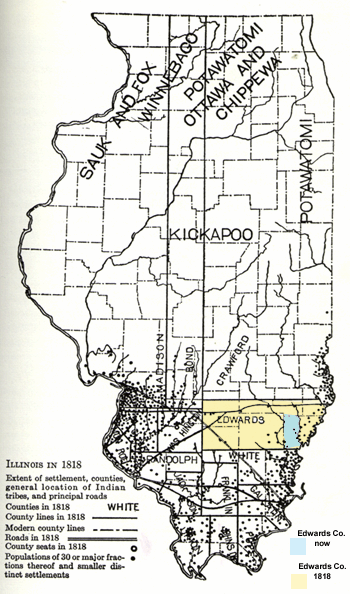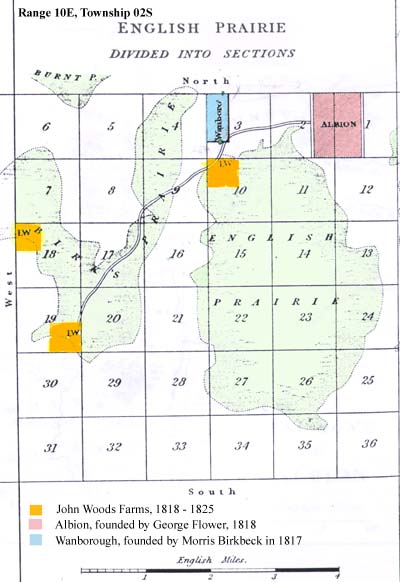Albion and Wanboro, Illinois, 1818
Founders
Morris Birkbeck and George Flower founded one of the earliest settlements in Illinois. Morris Birkbeck was from Wanborough, Surrey, England. He was born in 1764 to a Quaker family. As a child he was sent to a farm to learn agronomy. By adulthood he had learned enough to become a successful farmer, finally leasing a 1,500 acre farm near Guilford, Surrey.

Buck, Solon J. (1967). Illinois in 1818. University of Illinois Press, Urbana; p. 53.
George Flower was a friend of Birkbeck. They traveled in France for three months. In 1816, as Birkbeck's lease was expiring, he began to think about emigrating to avoid England's high taxes and prices. That year Flower traveled in America and wrote letters home, which also piqued Birkbeck's interest.
Flower was interested in the government of the United States and worried about his own farming situation, but he had not yet decided to move there permanently. As he traveled west, he tried to find out about the prairies he had read about. By the time he reached Kentucky and verified the existence of Illinois prairie, it was October and too late to see them unburned. He made his way back to Philadelphia, where he heard that Birkbeck was coming to the United States the following spring.
In April, 1817, Morris Birkbeck and five of his children, a servant, and a cousin of Flower boarded the ship America bound for Norfolk, Virginia. The trip took fifty days by sailing ship in those days. George Flower met them in Richmond, Virginia.
The group decided to go west, without a specific destination. They outfitted themselves with horses and equipment. It was a difficult journey, with falls, accidents, flooding, and hot sun. They finally reached Illinois and ventured onto Big Prairie, a low, wet prairie, and were given directions to Boltenhouse Prairie. The road was a barely-discernible wagon track they followed for seven hours. Here is what they saw:
"At first, we only received the impressions of its general beauty. With
longer gaze, all its distinctive features were revealed, lying in profound
repose under the warm light of an afternoon's summer sun. Its indented and
irregular outline of wood, its varied surface interspersed with clumps of
oaks of centuries' growth, its tall grass, with seed stalks from sic to ten
feet high, like tall grass, with seed stalks from six to ten feet high, like
tall and slender reeds waving in a gentle breeze, the whole presenting a magnificence
of park-scenery, complete from the hand of Nature, and unrivalled by the same
sort of scenery by European art."
___ George Flower
A few days later, when they were leaving Illinois, they made their decision. Birkbeck went to Shawneetown to register the land around Boltenhouse Prairie, as much as they could afford to buy (3,000 acres). Flower was to leave for England to send Birkbeck enough money to buy the whole prairie.
Development
Flower completed his mission to secure money and immigrants. The first settlers arrived in 1818. They consisted of friends and acquaintances of Birkbeck, and some tradesmen from London and elsewhere. Some settled in Birkbeck's village of Wanboro, and others settled in Flower's Albion.
Flower describes the first three years in Albion as difficult. Before settlers could be self-sufficient with their own crops, the land had to be cleared, cabins built, and wells dug. While this was progressing, they had to buy groceries and other goods from the German settlement, Harmonie, Indiana, 25 miles away, and haul them to Albion. Flower estimated that the people of Wanboro spent about $150,000 in Harmonie.
Flower, who had money from his holdings in England, bought livestock to start his farm. He bought 30 head of cattle for sixteen dollars each. His father bought 60 steers and a bull in Kentucky. This helped support the village until crops could be grown and harvested.

Another difficulty was the low price of crops once they went to market. Corn sold for ten-to-twelve cents per bushel, pork at two cents per pound, and beef at one-and-a-half cents per pound. That made it too expensive to hire laborers to help with farm work.
Albion continued to grow. As the first farmers made a success of their farms, they wrote back home to England. Their stories encouraged relatives and friends to try their luck in Illinois. New arrivals might work for settled farmers for a time (earning fifty to seventy-five cents per day), saving their money and buying their own land after several years. Some immigrants were not even farmers, but learned how to farm from their neighbors.
Story of an Immigrant
John Woods and his wife, two daughters and three sons, who were from Chiddingfold, Surrey, England, were examples of English settlers. Woods was a prosperous farmer who owned 70 acres freehold. It is not known why he wished to move to the United States. Woods arrived in 1818 and bought land from some other farmers who had settled earlier (Sam Slocumb, Jr., and Samuel Anderson). He and his sons worked the land, and improved the cabins. John moved to Albion in 1825 and took over a two-story brick tavern owned by Richard Flower. In 1827, the couple moved to Shawneetown and ran another tavern. John died in 1831, after which his wife returned to run the tavern in Albion. She died in 1838. Perhaps their children continued to farm ? here was a registered land purchase by a John Woods in 1836.
Woods wrote a journal of his journey from England to Illinois. Two years later he wrote about his experience in starting a farm, having been too occupied with farming to keep his journal. In it are lists and descriptions of the many wild and cultivated plants he gathered, grew, and planned to raise. He sent the manuscript to London to publish so that others might learn about life on the prairie.
